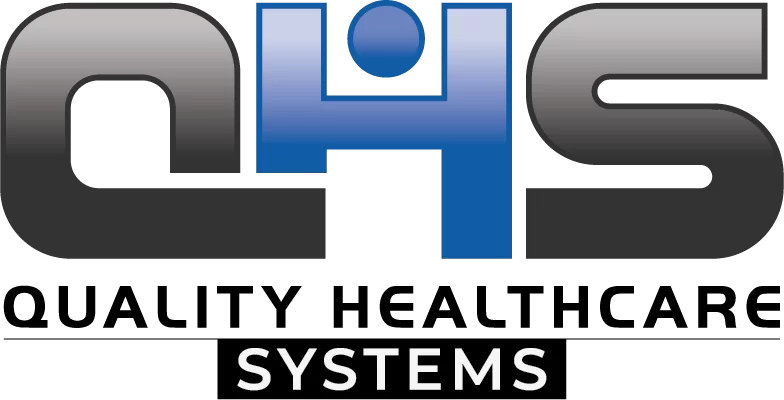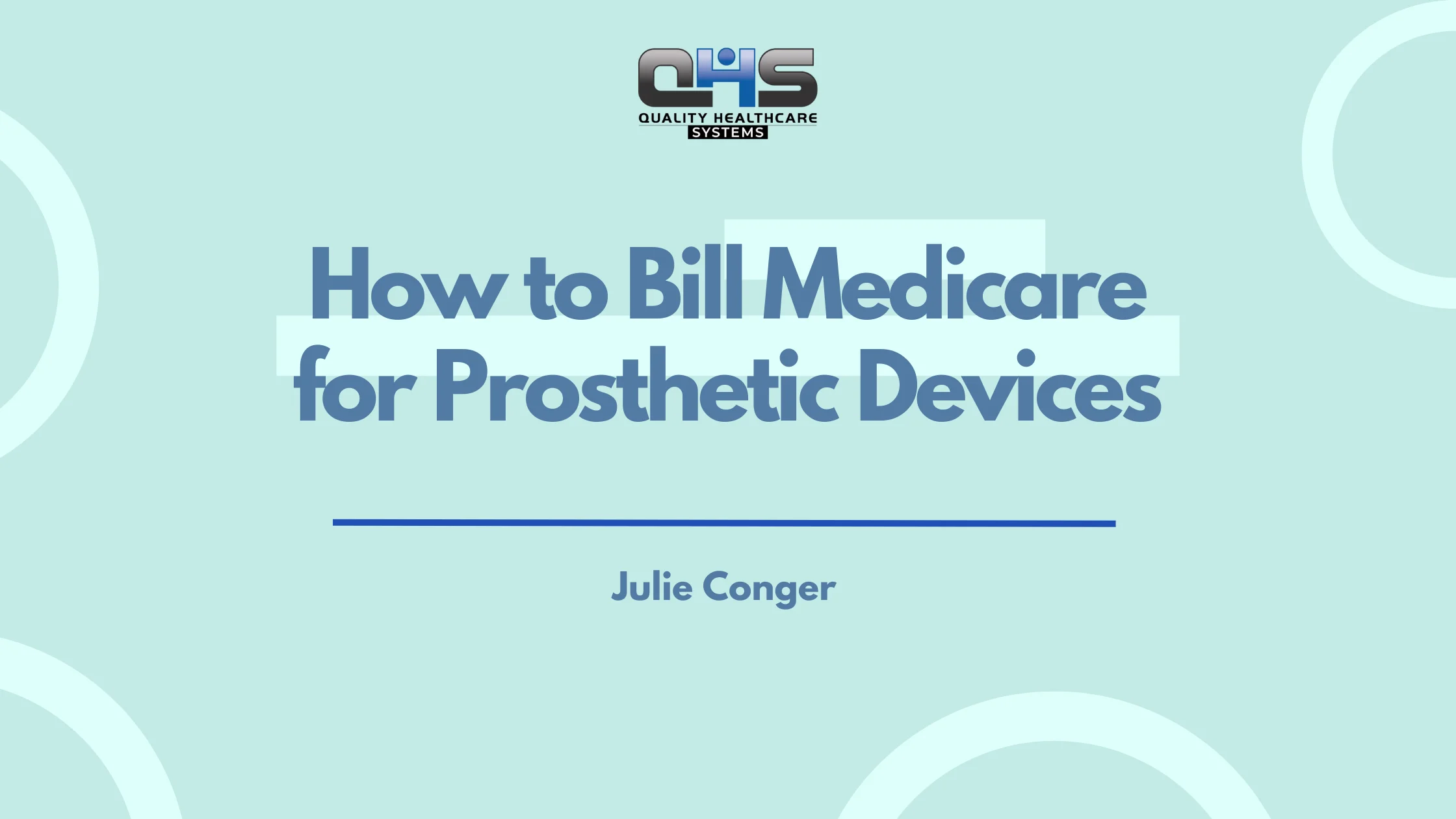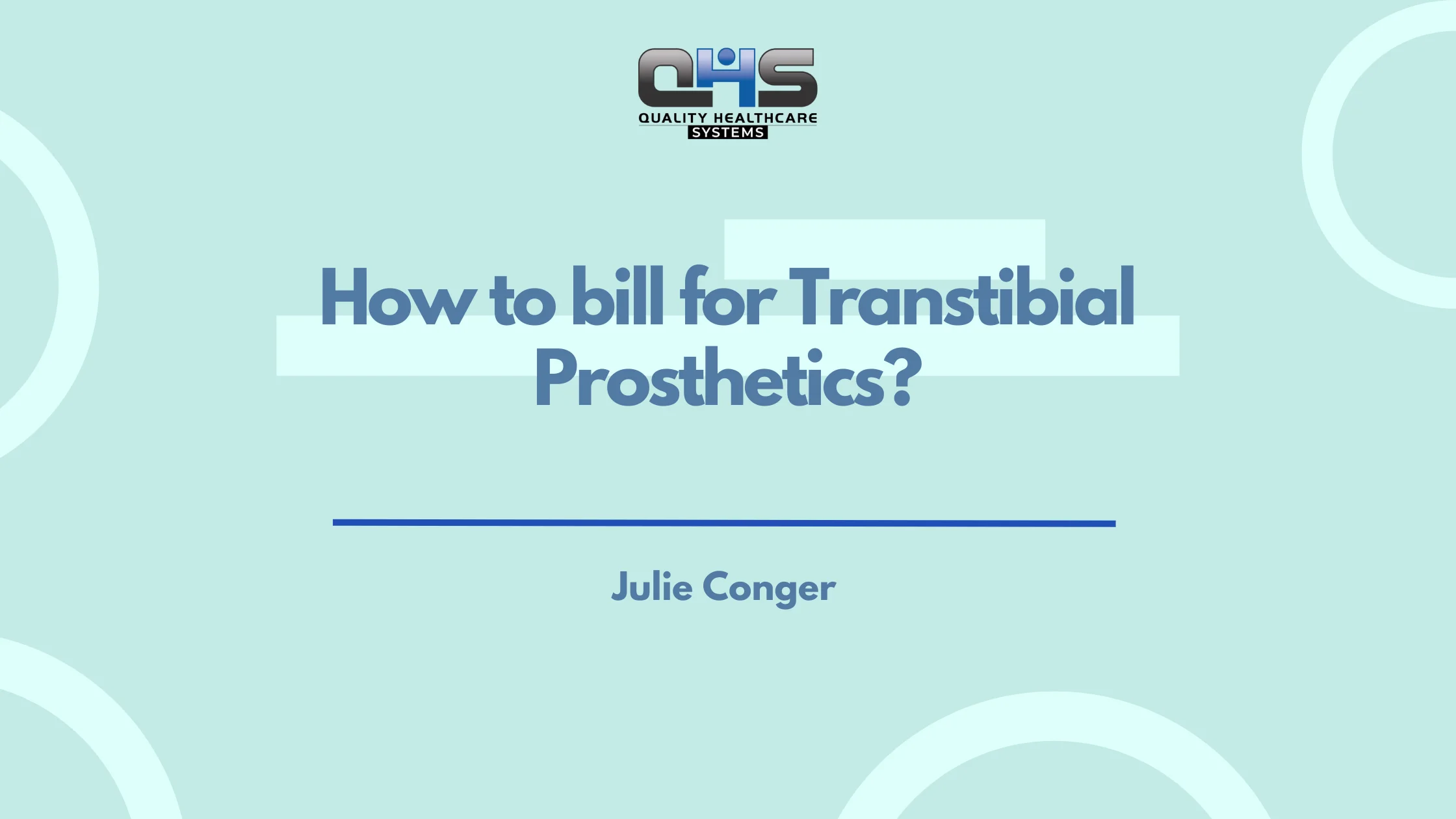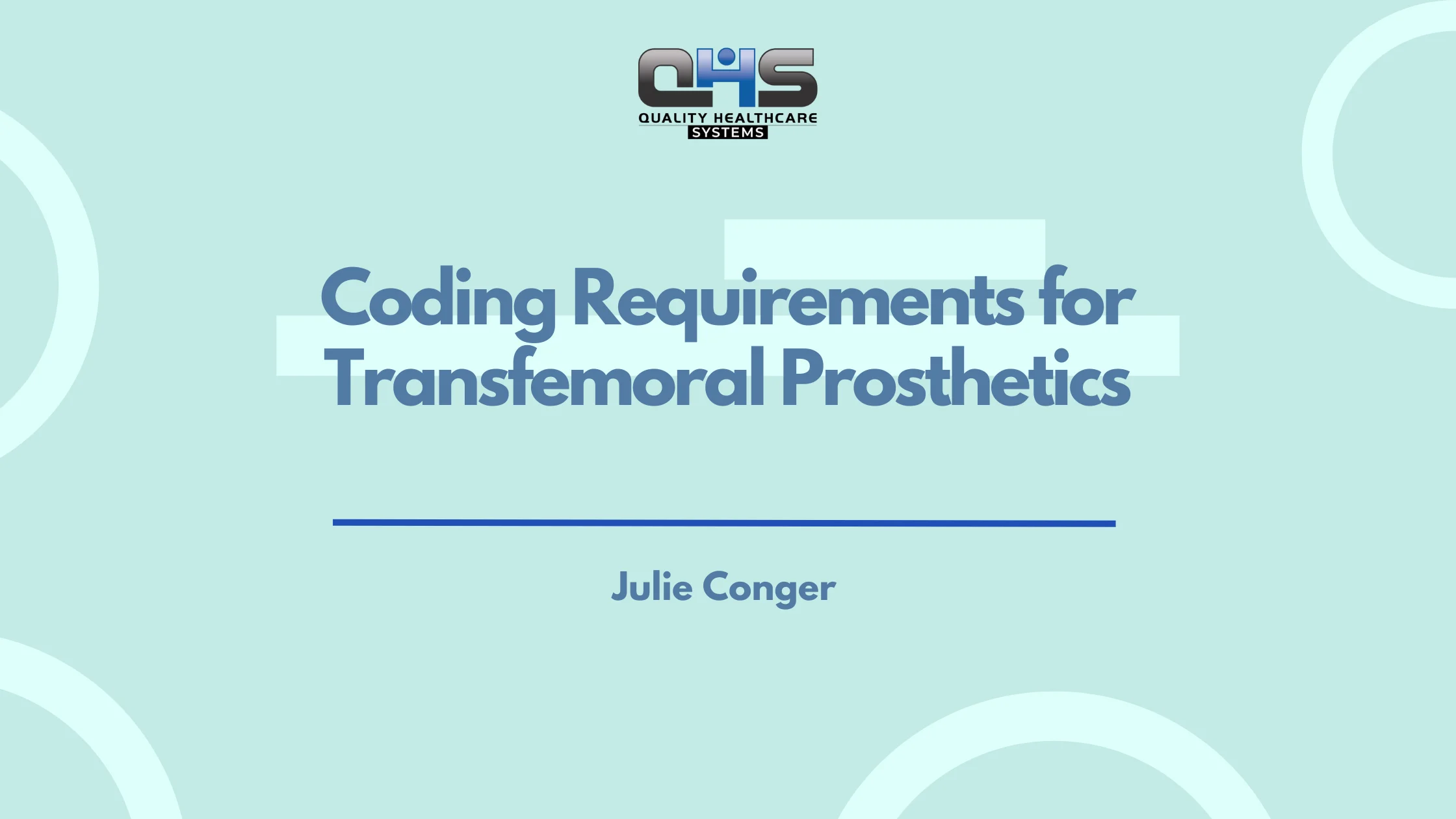Over 1.6 million Americans live with limb loss, and nearly 185,000 amputations occur annually—many of which depend on Medicare-covered prosthetic devices.
For DMEPOS suppliers, billing Medicare for these life-changing prosthetics isn’t just about forms and codes—it’s a high-stakes process that determines whether patients get timely access to care.
With strict compliance requirements, evolving HCPCS codes, and rising audit risks, suppliers must navigate Medicare’s billing protocols with precision. If you’ve ever faced a denied claim or struggled with modifier usage, you’re not alone—and the financial implications can be significant.
This guide breaks down everything you need to know to bill Medicare for prosthetic devices accurately and efficiently—from eligibility checks and physician documentation to coding, modifiers, audits, and appeal strategies.
What Does It Mean to Bill Medicare for Prosthetic Devices Under DMEPOS?
Billing Medicare for prosthetic devices under DMEPOS means submitting claims for Medicare Part B reimbursement using specific guidelines for durable medical equipment, prosthetics, orthotics, and supplies. Suppliers must follow CMS coverage policies, documentation standards, and coding requirements.
DMEPOS suppliers must enroll with Medicare and comply with rules outlined by Medicare Administrative Contractors (MACs). Prosthetic billing includes verifying patient eligibility, establishing medical necessity, obtaining a Standard Written Order (SWO), and submitting claims with accurate HCPCS codes.
Claims must also meet delivery verification, modifiers, and documentation protocols. The goal is to ensure appropriate use and prevent fraud while securing timely payment.
Which Prosthetic Devices are covered by Medicare in 2025?
Medicare Part B covers prosthetic devices that replace all or part of a body organ or limb and are deemed medically necessary. Covered items include artificial limbs, breast prostheses, and specific functional components based on the beneficiary’s condition.
Coverage depends on compliance with Local Coverage Determinations (LCDs) and medical necessity requirements. Examples include:
-
Lower limb prostheses (e.g., knees, feet, ankles)
-
Upper limb prostheses (e.g., hands, elbows)
-
Functional additions (microprocessor knees, energy-storing feet)
-
Breast prostheses post-mastectomy
-
Eye prostheses
All devices must be ordered by a physician and supported by medical records demonstrating need and intended use.
How Does Medicare Define Medical Necessity for Prosthetic Billing?
Medicare defines medical necessity as services or items that are reasonable and required for the diagnosis or treatment of illness or injury. For prosthetic billing, medical necessity is established through physician documentation and patient-specific clinical indications.
For example, lower limb prosthetics require documentation of amputation level, functional capabilities (K-level), and potential for rehabilitation. The treating physician’s records must demonstrate the patient’s need for the specific device and its components. If medical records fail to justify the billed prosthetic’s features, the claim may be denied as not reasonable and necessary.
What Documentation Is Required to Bill Medicare for Prosthetics?
To bill Medicare for prosthetics, suppliers must submit a Standard Written Order (SWO), medical records from the treating practitioner, proof of delivery, and documentation supporting continued use or need. All documents must align with LCD and policy criteria.
Key required documents include:
-
SWO: Signed and dated by physician before delivery
-
Medical records: Must contain detailed clinical notes from the treating physician
-
Proof of delivery: Patient signature and delivery method
-
Functional assessment: For advanced prosthetics (e.g., microprocessor knees)
-
Continued use: Supplier documentation showing device is still in use
All documentation must be available to Medicare upon request or audit.
What Is a Standard Written Order (SWO) and Why Is It Mandatory?
A Standard Written Order (SWO) is a required document that serves as the official prescription for a prosthetic device. Medicare mandates it before claim submission to ensure coverage and compliance.
An SWO must include:
-
Beneficiary’s name
-
Order date
-
Description of the item (HCPCS or narrative)
-
Quantity and frequency (if applicable)
-
Practitioner’s name and signature
The SWO must be signed before the prosthetic is delivered or billed. Without a valid SWO, the claim will be denied under Section 1833(e) of the Social Security Act due to insufficient documentation.
What Are the Required HCPCS Codes for Prosthetic Devices?
HCPCS Level II codes are mandatory for billing Medicare for prosthetic devices. Each prosthetic component has a specific L-code (e.g., L5856 for microprocessor knee), which determines coverage, pricing, and medical necessity requirements under Medicare DMEPOS guidelines.
Suppliers must accurately assign HCPCS L-codes based on the exact components provided. Common examples include:
-
L5000: Partial foot prosthesis
-
L5610-L5780: Socket components
-
L5820-L5859: Knee joints and controls
-
L5970-L5987: Foot systems
-
L8030: Breast prosthesis
Claims must match clinical documentation and device specifications. Errors in coding can result in denials or audits.
Related Posts:
- Medical Billing for Artificial Limbs
- Medical Billing for Orthopedic Support
- Medical Billing for Hemipelvectomy Prosthetic
- Medical Billing for Spinal Orthoses
- Prosthetic Billing for Lower Limbs
What Are the Medicare Modifiers for Prosthetics Claims?
Modifiers like RT, LT, RR, and NU are required for Medicare prosthetics medical billing to specify laterality and equipment status. Their use impacts reimbursement and helps Medicare validate claims for single or bilateral devices and rental or new equipment.
Common modifiers include:
-
LT / RT: Identifies left or right side (must be used with L-codes)
-
NU: New equipment
-
RR: Rental (typically not used for prosthetics)
-
KX: Documentation on file supporting medical necessity
-
GA: Waiver of liability (ABN issued)
Incorrect or missing modifiers can result in claim rejection or reduced payment.
How Do You Determine the Patient’s K-Level and Why Does It Matter?
K-level (Functional Level 0–4) determines the type of prosthetic components Medicare will cover. It is based on the patient’s potential to ambulate and is documented by the physician and/or prosthetist using clinical evaluations.
K-levels define functional capability:
-
K0: No ability to ambulate—no prosthesis covered
-
K1: Limited mobility—basic prosthetics only
-
K2: Community ambulator—additional stability features allowed
-
K3: Variable cadence—advanced components (e.g., energy-storing feet)
-
K4: High activity—covers sports/advanced prosthetics
Documentation must support the assigned K-level with measurable assessments (e.g., gait analysis, physical therapy reports).
When Should the Supplier Obtain Proof of Delivery (POD)?
Proof of Delivery (POD) must be obtained on or before the date of service billed and kept on file for at least 7 years. Without POD, the claim is not payable under Medicare rules, regardless of medical necessity.
Acceptable POD documentation includes:
-
Beneficiary name
-
Delivery date
-
Quantity and item description (matching HCPCS code)
-
Signature of recipient or authorized agent
For items shipped, tracking documentation plus signature confirmation is required. For in-person delivery, the beneficiary’s signature on the delivery form is mandatory.
What Are the Steps for Submitting a Medicare Prosthetic Claim?
To submit a Medicare prosthetic claim, suppliers must ensure documentation readiness, assign correct HCPCS and modifiers, verify coverage, and file the claim through the appropriate DME MAC via electronic billing systems (EDI).
Step-by-step process:
-
Verify Medicare eligibility and benefits
-
Obtain a signed SWO and supporting documentation
-
Assign correct L-codes and modifiers
-
Submit electronic claim via EDI with MAC jurisdiction
-
Track claim status and respond to any ADRs or denials
How Do You Handle Same or Similar Denials?
To bill Medicare for prosthetic devices after a same or similar denial, suppliers must provide documentation proving medical necessity, explain why the new device is needed, and submit an appeal with supporting clinical justification to override the previous coverage history.
Key steps:
-
Review the Common Working File (CWF) to identify previous device claims
-
Confirm replacement meets Medicare’s criteria: worn out, lost, or patient condition changed
-
Submit updated physician documentation and detailed narrative explaining the replacement need
-
Attach KX modifier if required and appeal with redetermination request if denied
What Is the Role of Face-to-Face Encounter and SWO?
To bill Medicare for prosthetic devices, a face-to-face encounter within 6 months and a signed Standard Written Order (SWO) are mandatory before delivery. These confirm the medical necessity and compliance with CMS documentation requirements for prosthetic items.
Face-to-face visit must:
-
Be conducted by a Medicare-enrolled physician, PA, NP, or CNS
-
Occur within 6 months prior to the written order
-
Address the patient’s prosthetic need and functionality
SWO must include:
-
Beneficiary name
-
Order date
-
Detailed description of item (HCPCS)
-
Quantity and treating practitioner’s signature
When Should You Use the KX Modifier?
When billing Medicare for prosthetic devices, use the KX modifier only if all required documentation is on file supporting the medical necessity, including physician notes, K-level assessment, and detailed descriptions matching the HCPCS codes billed.
Appropriate use includes:
-
K-level assessments documented by clinician
-
Prosthesis appropriate for K-level (e.g., microprocessor knee for K3/K4)
-
Matching components, modifiers, and justification
Misuse of KX without complete records can lead to overpayment recovery or claim audits. It signifies that the supplier accepts liability for accurate documentation.
How to Check Medicare Eligibility Before Billing?
To bill Medicare for prosthetic devices, verify patient eligibility by accessing the DME MAC’s IVR system, NGSConnex, or using a clearinghouse. Confirm Medicare Part B status, deductible status, coverage, and any same or similar equipment history.
Eligibility check includes:
-
Medicare Beneficiary Identifier (MBI)
-
Effective dates of Part B coverage
-
HMO enrollment (Medicare Advantage disqualifies FFS billing)
-
Recent DME claims that may cause denials
Documentation from the eligibility verification must be retained to defend claim submissions if questioned by CMS or auditors.
How Do You Document Functional Status to Support Billing?
To bill Medicare for prosthetic devices, document functional status through clinician notes, K-level assessments, and therapy records that justify the patient’s need and ability to use the prosthesis. The documentation must align with components billed and demonstrate medical necessity.
Acceptable documentation includes:
-
Physician progress notes detailing ambulation goals
-
Prosthetist evaluations outlining component selection
-
Physical therapist assessments (if applicable)
-
Objective measures like gait tests, strength, balance
All notes must be legible, dated, signed, and clearly tied to the device components billed. Mismatch between documentation and codes will result in denials.
How to Use K-Level Assessments in Billing?
K-level assessments determine a patient’s rehabilitation potential and are essential for selecting the correct prosthetic components for billing. Each K-level supports specific HCPCS codes that you can use when you bill Medicare for prosthetic devices.
For prosthetic billing:
-
K0 – No ambulation ability: Not eligible for prosthetic coverage.
-
K1–K4 – Increasing mobility: Supports billing for progressively advanced components.
K-level documentation by a licensed clinician must be detailed, medically necessary, and align with the billed device. Discrepancies between K-levels and components billed can lead to claim denials.
Prosthetic Billing Codes
| Code | Description |
|---|---|
| L5000 | PARTIAL FOOT, SHOE INSERT WITH LONGITUDINAL ARCH, TOE FILLER |
| L5010 | PARTIAL FOOT, MOLDED SOCKET, ANKLE HEIGHT, WITH TOE FILLER |
| L5020 | PARTIAL FOOT, MOLDED SOCKET, TIBIAL TUBERCLE HEIGHT, WITH TOE FILLER |
| L5050 | ANKLE, SYMES, MOLDED SOCKET, SACH FOOT |
| L5060 | ANKLE, SYMES, METAL FRAME, MOLDED LEATHER SOCKET, ARTICULATED ANKLE/FOOT |
| L5100 | BELOW KNEE, MOLDED SOCKET, SHIN, SACH FOOT |
| L5105 | BELOW KNEE, PLASTIC SOCKET, JOINTS AND THIGH LACER, SACH FOOT |
| L5150 | KNEE DISARTICULATION (OR THROUGH KNEE), MOLDED SOCKET, EXTERNAL KNEE JOINTS, SHIN, SACH FOOT |
| L5160 | KNEE DISARTICULATION (OR THROUGH KNEE), MOLDED SOCKET, BENT KNEE CONFIGURATION, EXTERNAL KNEE JOINTS, SHIN, SACH FOOT |
| L5200 | ABOVE KNEE, MOLDED SOCKET, SINGLE AXIS CONSTANT FRICTION KNEE, SHIN, SACH FOOT |
| L5210 | ABOVE KNEE, SHORT PROSTHESIS, NO KNEE JOINT (‘STUBBIES’), WITH FOOT BLOCKS, NO ANKLE JOINTS, EACH |
| L5220 | ABOVE KNEE, SHORT PROSTHESIS, NO KNEE JOINT (‘STUBBIES’), WITH ARTICULATED ANKLE/FOOT, DYNAMICALLY ALIGNED, EACH |
| L5230 | ABOVE KNEE, FOR PROXIMAL FEMORAL FOCAL DEFICIENCY, CONSTANT FRICTION KNEE, SHIN, SACH FOOT |
| L5250 | HIP DISARTICULATION, CANADIAN TYPE; MOLDED SOCKET, HIP JOINT, SINGLE AXIS CONSTANT FRICTION KNEE, SHIN, SACH FOOT |
| L5270 | HIP DISARTICULATION, TILT TABLE TYPE; MOLDED SOCKET, LOCKING HIP JOINT, SINGLE AXIS CONSTANT FRICTION KNEE, SHIN, SACH FOOT |
| L5280 | HEMIPELVECTOMY, CANADIAN TYPE; MOLDED SOCKET, HIP JOINT, SINGLE AXIS CONSTANT FRICTION KNEE, SHIN, SACH FOOT |
| L5301 | BELOW KNEE, MOLDED SOCKET, SHIN, SACH FOOT, ENDOSKELETAL SYSTEM |
| L5312 | KNEE DISARTICULATION (OR THROUGH KNEE), MOLDED SOCKET, SINGLE AXIS KNEE, PYLON, SACH FOOT, ENDOSKELETAL SYSTEM |
| L5321 | ABOVE KNEE, MOLDED SOCKET, OPEN END, SACH FOOT, ENDOSKELETAL SYSTEM, SINGLE AXIS KNEE |
| L5331 | HIP DISARTICULATION, CANADIAN TYPE, MOLDED SOCKET, ENDOSKELETAL SYSTEM, HIP JOINT, SINGLE AXIS KNEE, SACH FOOT |
| L5341 | HEMIPELVECTOMY, CANADIAN TYPE, MOLDED SOCKET, ENDOSKELETAL SYSTEM, HIP JOINT, SINGLE AXIS KNEE, SACH FOOT |
| L5400 | IMMEDIATE POST SURGICAL OR EARLY FITTING, APPLICATION OF INITIAL RIGID DRESSING, INCLUDING FITTING, ALIGNMENT, SUSPENSION, AND ONE CAST CHANGE, BELOW KNEE |
| L5410 | IMMEDIATE POST SURGICAL OR EARLY FITTING, APPLICATION OF INITIAL RIGID DRESSING, INCLUDING FITTING, ALIGNMENT AND SUSPENSION, BELOW KNEE, EACH ADDITIONAL CAST CHANGE AND REALIGNMENT |
| L5420 | IMMEDIATE POST SURGICAL OR EARLY FITTING, APPLICATION OF INITIAL RIGID DRESSING, INCLUDING FITTING, ALIGNMENT AND SUSPENSION AND ONE CAST CHANGE ‘AK’ OR KNEE DISARTICULATION |
| L5430 | IMMEDIATE POST SURGICAL OR EARLY FITTING, APPLICATION OF INITIAL RIGID DRESSING, INCL. FITTING, ALIGNMENT AND SUPENSION, ‘AK’ OR KNEE DISARTICULATION, EACH ADDITIONAL CAST CHANGE AND REALIGNMENT |
| L5450 | IMMEDIATE POST SURGICAL OR EARLY FITTING, APPLICATION OF NON-WEIGHT BEARING RIGID DRESSING, BELOW KNEE |
| L5460 | IMMEDIATE POST SURGICAL OR EARLY FITTING, APPLICATION OF NON-WEIGHT BEARING RIGID DRESSING, ABOVE KNEE |
| L5500 | INITIAL, BELOW KNEE ‘PTB’ TYPE SOCKET, NON-ALIGNABLE SYSTEM, PYLON, NO COVER, SACH FOOT, PLASTER SOCKET, DIRECT FORMED |
| L5505 | INITIAL, ABOVE KNEE – KNEE DISARTICULATION, ISCHIAL LEVEL SOCKET, NON-ALIGNABLE SYSTEM, PYLON, NO COVER, SACH FOOT, PLASTER SOCKET, DIRECT FORMED |
| L5510 | PREPARATORY, BELOW KNEE ‘PTB’ TYPE SOCKET, NON-ALIGNABLE SYSTEM, PYLON, NO COVER, SACH FOOT, PLASTER SOCKET, MOLDED TO MODEL |
| L5520 | PREPARATORY, BELOW KNEE ‘PTB’ TYPE SOCKET, NON-ALIGNABLE SYSTEM, PYLON, NO COVER, SACH FOOT, THERMOPLASTIC OR EQUAL, DIRECT FORMED |
| L5530 | PREPARATORY, BELOW KNEE ‘PTB’ TYPE SOCKET, NON-ALIGNABLE SYSTEM, PYLON, NO COVER, SACH FOOT, THERMOPLASTIC OR EQUAL, MOLDED TO MODEL |
| L5535 | PREPARATORY, BELOW KNEE ‘PTB’ TYPE SOCKET, NON-ALIGNABLE SYSTEM, NO COVER, SACH FOOT, PREFABRICATED, ADJUSTABLE OPEN END SOCKET |
| L5540 | PREPARATORY, BELOW KNEE ‘PTB’ TYPE SOCKET, NON-ALIGNABLE SYSTEM, PYLON, NO COVER, SACH FOOT, LAMINATED SOCKET, MOLDED TO MODEL |
| L5560 | PREPARATORY, ABOVE KNEE- KNEE DISARTICULATION, ISCHIAL LEVEL SOCKET, NON-ALIGNABLE SYSTEM, PYLON, NO COVER, SACH FOOT, PLASTER SOCKET, MOLDED TO MODEL |
| L5570 | PREPARATORY, ABOVE KNEE – KNEE DISARTICULATION, ISCHIAL LEVEL SOCKET, NON-ALIGNABLE SYSTEM, PYLON, NO COVER, SACH FOOT, THERMOPLASTIC OR EQUAL, DIRECT FORMED |
| L5580 | PREPARATORY, ABOVE KNEE – KNEE DISARTICULATION ISCHIAL LEVEL SOCKET, NON-ALIGNABLE SYSTEM, PYLON, NO COVER, SACH FOOT, THERMOPLASTIC OR EQUAL, MOLDED TO MODEL |
| L5585 | PREPARATORY, ABOVE KNEE – KNEE DISARTICULATION, ISCHIAL LEVEL SOCKET, NON-ALIGNABLE SYSTEM, PYLON, NO COVER, SACH FOOT, PREFABRICATED ADJUSTABLE OPEN END SOCKET |
| L5590 | PREPARATORY, ABOVE KNEE – KNEE DISARTICULATION ISCHIAL LEVEL SOCKET, NON-ALIGNABLE SYSTEM, PYLON NO COVER, SACH FOOT, LAMINATED SOCKET, MOLDED TO MODEL |
| L5595 | PREPARATORY, HIP DISARTICULATION-HEMIPELVECTOMY, PYLON, NO COVER, SACH FOOT, THERMOPLASTIC OR EQUAL, MOLDED TO PATIENT MODEL |
| L5600 | PREPARATORY, HIP DISARTICULATION-HEMIPELVECTOMY, PYLON, NO COVER, SACH FOOT, LAMINATED SOCKET, MOLDED TO PATIENT MODEL |
| L5610 | ADDITION TO LOWER EXTREMITY, ENDOSKELETAL SYSTEM, ABOVE KNEE, HYDRACADENCE SYSTEM |
| L5611 | ADDITION TO LOWER EXTREMITY, ENDOSKELETAL SYSTEM, ABOVE KNEE – KNEE DISARTICULATION, 4 BAR LINKAGE, WITH FRICTION SWING PHASE CONTROL |
| L5613 | ADDITION TO LOWER EXTREMITY, ENDOSKELETAL SYSTEM, ABOVE KNEE-KNEE DISARTICULATION, 4 BAR LINKAGE, WITH HYDRAULIC SWING PHASE CONTROL |
| L5614 | ADDITION TO LOWER EXTREMITY, EXOSKELETAL SYSTEM, ABOVE KNEE-KNEE DISARTICULATION, 4 BAR LINKAGE, WITH PNEUMATIC SWING PHASE CONTROL |
| L5615 | ADDITION, ENDOSKELETAL KNEE-SHIN SYSTEM, 4 BAR LINKAGE OR MULTIAXIAL, FLUID SWING AND STANCE PHASE CONTROL |
| L5616 | ADDITION TO LOWER EXTREMITY, ENDOSKELETAL SYSTEM, ABOVE KNEE, UNIVERSAL MULTIPLEX SYSTEM, FRICTION SWING PHASE CONTROL |
| L5617 | ADDITION TO LOWER EXTREMITY, QUICK CHANGE SELF-ALIGNING UNIT, ABOVE KNEE OR BELOW KNEE, EACH |
| L5618 | ADDITION TO LOWER EXTREMITY, TEST SOCKET, SYMES |
| L5620 | ADDITION TO LOWER EXTREMITY, TEST SOCKET, BELOW KNEE |
| L5622 | ADDITION TO LOWER EXTREMITY, TEST SOCKET, KNEE DISARTICULATION |
| L5624 | ADDITION TO LOWER EXTREMITY, TEST SOCKET, ABOVE KNEE |
| L5626 | ADDITION TO LOWER EXTREMITY, TEST SOCKET, HIP DISARTICULATION |
| L5628 | ADDITION TO LOWER EXTREMITY, TEST SOCKET, HEMIPELVECTOMY |
| L5629 | ADDITION TO LOWER EXTREMITY, BELOW KNEE, ACRYLIC SOCKET |
| L5630 | ADDITION TO LOWER EXTREMITY, SYMES TYPE, EXPANDABLE WALL SOCKET |
| L5631 | ADDITION TO LOWER EXTREMITY, ABOVE KNEE OR KNEE DISARTICULATION, ACRYLIC SOCKET |
| L5632 | ADDITION TO LOWER EXTREMITY, SYMES TYPE, ‘PTB’ BRIM DESIGN SOCKET |
| L5634 | ADDITION TO LOWER EXTREMITY, SYMES TYPE, POSTERIOR OPENING (CANADIAN) SOCKET |
| L5636 | ADDITION TO LOWER EXTREMITY, SYMES TYPE, MEDIAL OPENING SOCKET |
| L5637 | ADDITION TO LOWER EXTREMITY, BELOW KNEE, TOTAL CONTACT |
| L5638 | ADDITION TO LOWER EXTREMITY, BELOW KNEE, LEATHER SOCKET |
| L5639 | ADDITION TO LOWER EXTREMITY, BELOW KNEE, WOOD SOCKET |
| L5640 | ADDITION TO LOWER EXTREMITY, KNEE DISARTICULATION, LEATHER SOCKET |
| L5642 | ADDITION TO LOWER EXTREMITY, ABOVE KNEE, LEATHER SOCKET |
| L5643 | ADDITION TO LOWER EXTREMITY, HIP DISARTICULATION, FLEXIBLE INNER SOCKET, EXTERNAL FRAME |
| L5644 | ADDITION TO LOWER EXTREMITY, ABOVE KNEE, WOOD SOCKET |
| L5645 | ADDITION TO LOWER EXTREMITY, BELOW KNEE, FLEXIBLE INNER SOCKET, EXTERNAL FRAME |
| L5646 | ADDITION TO LOWER EXTREMITY, BELOW KNEE, AIR, FLUID, GEL OR EQUAL, CUSHION SOCKET |
| L5647 | ADDITION TO LOWER EXTREMITY, BELOW KNEE SUCTION SOCKET |
| L5648 | ADDITION TO LOWER EXTREMITY, ABOVE KNEE, AIR, FLUID, GEL OR EQUAL, CUSHION SOCKET |
| L5649 | ADDITION TO LOWER EXTREMITY, ISCHIAL CONTAINMENT/NARROW M-L SOCKET |
| L5650 | ADDITIONS TO LOWER EXTREMITY, TOTAL CONTACT, ABOVE KNEE OR KNEE DISARTICULATION SOCKET |
| L5651 | ADDITION TO LOWER EXTREMITY, ABOVE KNEE, FLEXIBLE INNER SOCKET, EXTERNAL FRAME |
| L5652 | ADDITION TO LOWER EXTREMITY, SUCTION SUSPENSION, ABOVE KNEE OR KNEE DISARTICULATION SOCKET |
| L5653 | ADDITION TO LOWER EXTREMITY, KNEE DISARTICULATION, EXPANDABLE WALL SOCKET |
| L5654 | ADDITION TO LOWER EXTREMITY, SOCKET INSERT, SYMES, (KEMBLO, PELITE, ALIPLAST, PLASTAZOTE OR EQUAL) |
| L5655 | ADDITION TO LOWER EXTREMITY, SOCKET INSERT, BELOW KNEE (KEMBLO, PELITE, ALIPLAST, PLASTAZOTE OR EQUAL) |
| L5656 | ADDITION TO LOWER EXTREMITY, SOCKET INSERT, KNEE DISARTICULATION (KEMBLO, PELITE, ALIPLAST, PLASTAZOTE OR EQUAL) |
| L5658 | ADDITION TO LOWER EXTREMITY, SOCKET INSERT, ABOVE KNEE (KEMBLO, PELITE, ALIPLAST, PLASTAZOTE OR EQUAL) |
| L5661 | ADDITION TO LOWER EXTREMITY, SOCKET INSERT, MULTI-DUROMETER SYMES |
| L5665 | ADDITION TO LOWER EXTREMITY, SOCKET INSERT, MULTI-DUROMETER, BELOW KNEE |
| L5666 | ADDITION TO LOWER EXTREMITY, BELOW KNEE, CUFF SUSPENSION |
| L5668 | ADDITION TO LOWER EXTREMITY, BELOW KNEE, MOLDED DISTAL CUSHION |
| L5670 | ADDITION TO LOWER EXTREMITY, BELOW KNEE, MOLDED SUPRACONDYLAR SUSPENSION (‘PTS’ OR SIMILAR) |
| L5671 | ADDITION TO LOWER EXTREMITY, BELOW KNEE / ABOVE KNEE SUSPENSION LOCKING MECHANISM (SHUTTLE, LANYARD OR EQUAL), EXCLUDES SOCKET INSERT |
| L5672 | ADDITION TO LOWER EXTREMITY, BELOW KNEE, REMOVABLE MEDIAL BRIM SUSPENSION |
| L5673 | ADDITION TO LOWER EXTREMITY, BELOW KNEE/ABOVE KNEE, CUSTOM FABRICATED FROM EXISTING MOLD OR PREFABRICATED, SOCKET INSERT, SILICONE GEL, ELASTOMERIC OR EQUAL, FOR USE WITH LOCKING MECHANISM |
| L5676 | ADDITIONS TO LOWER EXTREMITY, BELOW KNEE, KNEE JOINTS, SINGLE AXIS, PAIR |
| L5677 | ADDITIONS TO LOWER EXTREMITY, BELOW KNEE, KNEE JOINTS, POLYCENTRIC, PAIR |
| L5678 | ADDITIONS TO LOWER EXTREMITY, BELOW KNEE, JOINT COVERS, PAIR |
| L5679 | ADDITION TO LOWER EXTREMITY, BELOW KNEE/ABOVE KNEE, CUSTOM FABRICATED FROM EXISTING MOLD OR PREFABRICATED, SOCKET INSERT, SILICONE GEL, ELASTOMERIC OR EQUAL, NOT FOR USE WITH LOCKING MECHANISM |
| L5680 | ADDITION TO LOWER EXTREMITY, BELOW KNEE, THIGH LACER, NONMOLDED |
| L5681 | ADDITION TO LOWER EXTREMITY, BELOW KNEE/ABOVE KNEE, CUSTOM FABRICATED SOCKET INSERT FOR CONGENITAL OR ATYPICAL TRAUMATIC AMPUTEE, SILICONE GEL, ELASTOMERIC OR EQUAL, FOR USE WITH OR WITHOUT LOCKING MECHANISM, INITIAL ONLY (FOR OTHER THAN INITIAL, USE CODE L5673 OR L5679) |
| L5682 | ADDITION TO LOWER EXTREMITY, BELOW KNEE, THIGH LACER, GLUTEAL/ISCHIAL, MOLDED |
| L5683 | ADDITION TO LOWER EXTREMITY, BELOW KNEE/ABOVE KNEE, CUSTOM FABRICATED SOCKET INSERT FOR OTHER THAN CONGENITAL OR ATYPICAL TRAUMATIC AMPUTEE, SILICONE GEL, ELASTOMERIC OR EQUAL, FOR USE WITH OR WITHOUT LOCKING MECHANISM, INITIAL ONLY (FOR OTHER THAN INITIAL, USE CODE L5673 OR L5679) |
| L5684 | ADDITION TO LOWER EXTREMITY, BELOW KNEE, FORK STRAP |
| L5685 | ADDITION TO LOWER EXTREMITY PROSTHESIS, BELOW KNEE, SUSPENSION/SEALING SLEEVE, WITH OR WITHOUT VALVE, ANY MATERIAL, EACH |
| L5686 | ADDITION TO LOWER EXTREMITY, BELOW KNEE, BACK CHECK (EXTENSION CONTROL) |
| L5688 | ADDITION TO LOWER EXTREMITY, BELOW KNEE, WAIST BELT, WEBBING |
| L5690 | ADDITION TO LOWER EXTREMITY, BELOW KNEE, WAIST BELT, PADDED AND LINED |
| L5692 | ADDITION TO LOWER EXTREMITY, ABOVE KNEE, PELVIC CONTROL BELT, LIGHT |
| L5694 | ADDITION TO LOWER EXTREMITY, ABOVE KNEE, PELVIC CONTROL BELT, PADDED AND LINED |
| L5695 | ADDITION TO LOWER EXTREMITY, ABOVE KNEE, PELVIC CONTROL, SLEEVE SUSPENSION, NEOPRENE OR EQUAL, EACH |
| L5696 | ADDITION TO LOWER EXTREMITY, ABOVE KNEE OR KNEE DISARTICULATION, PELVIC JOINT |
| L5697 | ADDITION TO LOWER EXTREMITY, ABOVE KNEE OR KNEE DISARTICULATION, PELVIC BAND |
| L5698 | ADDITION TO LOWER EXTREMITY, ABOVE KNEE OR KNEE DISARTICULATION, SILESIAN BANDAGE |
| L5699 | ALL LOWER EXTREMITY PROSTHESES, SHOULDER HARNESS |
| L5700 | REPLACEMENT, SOCKET, BELOW KNEE, MOLDED TO PATIENT MODEL |
| L5701 | REPLACEMENT, SOCKET, ABOVE KNEE/KNEE DISARTICULATION, INCLUDING ATTACHMENT PLATE, MOLDED TO PATIENT MODEL |
| L5702 | REPLACEMENT, SOCKET, HIP DISARTICULATION, INCLUDING HIP JOINT, MOLDED TO PATIENT MODEL |
| L5703 | ANKLE, SYMES, MOLDED TO PATIENT MODEL, SOCKET WITHOUT SOLID ANKLE CUSHION HEEL (SACH) FOOT, REPLACEMENT ONLY |
| L5704 | CUSTOM SHAPED PROTECTIVE COVER, BELOW KNEE |
| L5705 | CUSTOM SHAPED PROTECTIVE COVER, ABOVE KNEE |
| L5706 | CUSTOM SHAPED PROTECTIVE COVER, KNEE DISARTICULATION |
| L5707 | CUSTOM SHAPED PROTECTIVE COVER, HIP DISARTICULATION |
| L5710 | ADDITION, EXOSKELETAL KNEE-SHIN SYSTEM, SINGLE AXIS, MANUAL LOCK |
| L5711 | ADDITIONS EXOSKELETAL KNEE-SHIN SYSTEM, SINGLE AXIS, MANUAL LOCK, ULTRA-LIGHT MATERIAL |
| L5712 | ADDITION, EXOSKELETAL KNEE-SHIN SYSTEM, SINGLE AXIS, FRICTION SWING AND STANCE PHASE CONTROL (SAFETY KNEE) |
| L5714 | ADDITION, EXOSKELETAL KNEE-SHIN SYSTEM, SINGLE AXIS, VARIABLE FRICTION SWING PHASE CONTROL |
| L5716 | ADDITION, EXOSKELETAL KNEE-SHIN SYSTEM, POLYCENTRIC, MECHANICAL STANCE PHASE LOCK |
| L5718 | ADDITION, EXOSKELETAL KNEE-SHIN SYSTEM, POLYCENTRIC, FRICTION SWING AND STANCE PHASE CONTROL |
| L5722 | ADDITION, EXOSKELETAL KNEE-SHIN SYSTEM, SINGLE AXIS, PNEUMATIC SWING, FRICTION STANCE PHASE CONTROL |
| L5724 | ADDITION, EXOSKELETAL KNEE-SHIN SYSTEM, SINGLE AXIS, FLUID SWING PHASE CONTROL |
| L5726 | ADDITION, EXOSKELETAL KNEE-SHIN SYSTEM, SINGLE AXIS, EXTERNAL JOINTS FLUID SWING PHASE CONTROL |
| L5728 | ADDITION, EXOSKELETAL KNEE-SHIN SYSTEM, SINGLE AXIS, FLUID SWING AND STANCE PHASE CONTROL |
| L5780 | ADDITION, EXOSKELETAL KNEE-SHIN SYSTEM, SINGLE AXIS, PNEUMATIC/HYDRA PNEUMATIC SWING PHASE CONTROL |
| L5781 | ADDITION TO LOWER LIMB PROSTHESIS, VACUUM PUMP, RESIDUAL LIMB VOLUME MANAGEMENT AND MOISTURE EVACUATION SYSTEM |
| L5782 | ADDITION TO LOWER LIMB PROSTHESIS, VACUUM PUMP, RESIDUAL LIMB VOLUME MANAGEMENT AND MOISTURE EVACUATION SYSTEM, HEAVY DUTY |
| L5783 | ADDITION TO LOWER EXTREMITY, USER ADJUSTABLE, MECHANICAL, RESIDUAL LIMB VOLUME MANAGEMENT SYSTEM |
| L5785 | ADDITION, EXOSKELETAL SYSTEM, BELOW KNEE, ULTRA-LIGHT MATERIAL (TITANIUM, CARBON FIBER OR EQUAL) |
| L5790 | ADDITION, EXOSKELETAL SYSTEM, ABOVE KNEE, ULTRA-LIGHT MATERIAL (TITANIUM, CARBON FIBER OR EQUAL) |
| L5795 | ADDITION, EXOSKELETAL SYSTEM, HIP DISARTICULATION, ULTRA-LIGHT MATERIAL (TITANIUM, CARBON FIBER OR EQUAL) |
| L5810 | ADDITION, ENDOSKELETAL KNEE-SHIN SYSTEM, SINGLE AXIS, MANUAL LOCK |
| L5811 | ADDITION, ENDOSKELETAL KNEE-SHIN SYSTEM, SINGLE AXIS, MANUAL LOCK, ULTRA-LIGHT MATERIAL |
| L5812 | ADDITION, ENDOSKELETAL KNEE-SHIN SYSTEM, SINGLE AXIS, FRICTION SWING AND STANCE PHASE CONTROL (SAFETY KNEE) |
| L5814 | ADDITION, ENDOSKELETAL KNEE-SHIN SYSTEM, POLYCENTRIC, HYDRAULIC SWING PHASE CONTROL, MECHANICAL STANCE PHASE LOCK |
| L5816 | ADDITION, ENDOSKELETAL KNEE-SHIN SYSTEM, POLYCENTRIC, MECHANICAL STANCE PHASE LOCK |
| L5818 | ADDITION, ENDOSKELETAL KNEE-SHIN SYSTEM, POLYCENTRIC, FRICTION SWING, AND STANCE PHASE CONTROL |
| L5822 | ADDITION, ENDOSKELETAL KNEE-SHIN SYSTEM, SINGLE AXIS, PNEUMATIC SWING, FRICTION STANCE PHASE CONTROL |
| L5824 | ADDITION, ENDOSKELETAL KNEE-SHIN SYSTEM, SINGLE AXIS, FLUID SWING PHASE CONTROL |
| L5826 | ADDITION, ENDOSKELETAL KNEE-SHIN SYSTEM, SINGLE AXIS, HYDRAULIC SWING PHASE CONTROL, WITH MINIATURE HIGH ACTIVITY FRAME |
| L5827 | ENDOSKELETAL KNEE-SHIN SYSTEM, SINGLE AXIS, ELECTROMECHANICAL SWING AND STANCE PHASE CONTROL, WITH OR WITHOUT SHOCK ABSORPTION AND STANCE EXTENSION DAMPING |
| L5828 | ADDITION, ENDOSKELETAL KNEE-SHIN SYSTEM, SINGLE AXIS, FLUID SWING AND STANCE PHASE CONTROL |
| L5830 | ADDITION, ENDOSKELETAL KNEE-SHIN SYSTEM, SINGLE AXIS, PNEUMATIC/ SWING PHASE CONTROL |
| L5840 | ADDITION, ENDOSKELETAL KNEE/SHIN SYSTEM, 4-BAR LINKAGE OR MULTIAXIAL, PNEUMATIC SWING PHASE CONTROL |
| L5841 | ADDITION, ENDOSKELETAL KNEE-SHIN SYSTEM, POLYCENTRIC, PNEUMATIC SWING, AND STANCE PHASE CONTROL |
| L5845 | ADDITION, ENDOSKELETAL, KNEE-SHIN SYSTEM, STANCE FLEXION FEATURE, ADJUSTABLE |
| L5848 | ADDITION TO ENDOSKELETAL KNEE-SHIN SYSTEM, FLUID STANCE EXTENSION, DAMPENING FEATURE, WITH OR WITHOUT ADJUSTABILITY |
| L5850 | ADDITION, ENDOSKELETAL SYSTEM, ABOVE KNEE OR HIP DISARTICULATION, KNEE EXTENSION ASSIST |
| L5855 | ADDITION, ENDOSKELETAL SYSTEM, HIP DISARTICULATION, MECHANICAL HIP EXTENSION ASSIST |
| L5856 | ADDITION TO LOWER EXTREMITY PROSTHESIS, ENDOSKELETAL KNEE-SHIN SYSTEM, MICROPROCESSOR CONTROL FEATURE, SWING AND STANCE PHASE, INCLUDES ELECTRONIC SENSOR(S), ANY TYPE |
| L5857 | ADDITION TO LOWER EXTREMITY PROSTHESIS, ENDOSKELETAL KNEE-SHIN SYSTEM, MICROPROCESSOR CONTROL FEATURE, SWING PHASE ONLY, INCLUDES ELECTRONIC SENSOR(S), ANY TYPE |
| L5858 | ADDITION TO LOWER EXTREMITY PROSTHESIS, ENDOSKELETAL KNEE SHIN SYSTEM, MICROPROCESSOR CONTROL FEATURE, STANCE PHASE ONLY, INCLUDES ELECTRONIC SENSOR(S), ANY TYPE |
| L5859 | ADDITION TO LOWER EXTREMITY PROSTHESIS, ENDOSKELETAL KNEE-SHIN SYSTEM, POWERED AND PROGRAMMABLE FLEXION/EXTENSION ASSIST CONTROL, INCLUDES ANY TYPE MOTOR(S) |
| L5910 | ADDITION, ENDOSKELETAL SYSTEM, BELOW KNEE, ALIGNABLE SYSTEM |
| L5920 | ADDITION, ENDOSKELETAL SYSTEM, ABOVE KNEE OR HIP DISARTICULATION, ALIGNABLE SYSTEM |
| L5925 | ADDITION, ENDOSKELETAL SYSTEM, ABOVE KNEE, KNEE DISARTICULATION OR HIP DISARTICULATION, MANUAL LOCK |
| L5926 | ADDITION TO LOWER EXTREMITY PROSTHESIS, ENDOSKELETAL, KNEE DISARTICULATION, ABOVE KNEE, HIP DISARTICULATION, POSITIONAL ROTATION UNIT, ANY TYPE |
| L5930 | ADDITION, ENDOSKELETAL SYSTEM, HIGH ACTIVITY KNEE CONTROL FRAME |
| L5940 | ADDITION, ENDOSKELETAL SYSTEM, BELOW KNEE, ULTRA-LIGHT MATERIAL (TITANIUM, CARBON FIBER OR EQUAL) |
| L5950 | ADDITION, ENDOSKELETAL SYSTEM, ABOVE KNEE, ULTRA-LIGHT MATERIAL (TITANIUM, CARBON FIBER OR EQUAL) |
| L5960 | ADDITION, ENDOSKELETAL SYSTEM, HIP DISARTICULATION, ULTRA-LIGHT MATERIAL (TITANIUM, CARBON FIBER OR EQUAL) |
| L5961 | ADDITION, ENDOSKELETAL SYSTEM, POLYCENTRIC HIP JOINT, PNEUMATIC OR HYDRAULIC CONTROL, ROTATION CONTROL, WITH OR WITHOUT FLEXION AND/OR EXTENSION CONTROL |
| L5962 | ADDITION, ENDOSKELETAL SYSTEM, BELOW KNEE, FLEXIBLE PROTECTIVE OUTER SURFACE COVERING SYSTEM |
| L5964 | ADDITION, ENDOSKELETAL SYSTEM, ABOVE KNEE, FLEXIBLE PROTECTIVE OUTER SURFACE COVERING SYSTEM |
| L5966 | ADDITION, ENDOSKELETAL SYSTEM, HIP DISARTICULATION, FLEXIBLE PROTECTIVE OUTER SURFACE COVERING SYSTEM |
| L5968 | ADDITION TO LOWER LIMB PROSTHESIS, MULTIAXIAL ANKLE WITH SWING PHASE ACTIVE DORSIFLEXION FEATURE |
| L5969 | ADDITION, ENDOSKELETAL ANKLE-FOOT OR ANKLE SYSTEM, POWER ASSIST, INCLUDES ANY TYPE MOTOR(S) |
| L5970 | ALL LOWER EXTREMITY PROSTHESES, FOOT, EXTERNAL KEEL, SACH FOOT |
| L5971 | ALL LOWER EXTREMITY PROSTHESIS, SOLID ANKLE CUSHION HEEL (SACH) FOOT, REPLACEMENT ONLY |
| L5972 | ALL LOWER EXTREMITY PROSTHESES, FOOT, FLEXIBLE KEEL |
| L5973 | ENDOSKELETAL ANKLE FOOT SYSTEM, MICROPROCESSOR CONTROLLED FEATURE, DORSIFLEXION AND/OR PLANTAR FLEXION CONTROL, INCLUDES POWER SOURCE |
| L5974 | ALL LOWER EXTREMITY PROSTHESES, FOOT, SINGLE AXIS ANKLE/FOOT |
| L5975 | ALL LOWER EXTREMITY PROSTHESIS, COMBINATION SINGLE AXIS ANKLE AND FLEXIBLE KEEL FOOT |
| L5976 | ALL LOWER EXTREMITY PROSTHESES, ENERGY STORING FOOT (SEATTLE CARBON COPY II OR EQUAL) |
| L5978 | ALL LOWER EXTREMITY PROSTHESES, FOOT, MULTIAXIAL ANKLE/FOOT |
| L5979 | ALL LOWER EXTREMITY PROSTHESIS, MULTI-AXIAL ANKLE, DYNAMIC RESPONSE FOOT, ONE PIECE SYSTEM |
| L5980 | ALL LOWER EXTREMITY PROSTHESES, FLEX FOOT SYSTEM |
| L5981 | ALL LOWER EXTREMITY PROSTHESES, FLEX-WALK SYSTEM OR EQUAL |
| L5982 | ALL EXOSKELETAL LOWER EXTREMITY PROSTHESES, AXIAL ROTATION UNIT |
| L5984 | ALL ENDOSKELETAL LOWER EXTREMITY PROSTHESIS, AXIAL ROTATION UNIT, WITH OR WITHOUT ADJUSTABILITY |
| L5985 | ALL ENDOSKELETAL LOWER EXTREMITY PROSTHESES, DYNAMIC PROSTHETIC PYLON |
| L5986 | ALL LOWER EXTREMITY PROSTHESES, MULTI-AXIAL ROTATION UNIT (‘MCP’ OR EQUAL) |
| L5987 | ALL LOWER EXTREMITY PROSTHESIS, SHANK FOOT SYSTEM WITH VERTICAL LOADING PYLON |
| L5988 | ADDITION TO LOWER LIMB PROSTHESIS, VERTICAL SHOCK REDUCING PYLON FEATURE |
| L5990 | ADDITION TO LOWER EXTREMITY PROSTHESIS, USER ADJUSTABLE HEEL HEIGHT |
| L5991 | ADDITION TO LOWER EXTREMITY PROSTHESES, OSSEOINTEGRATED EXTERNAL PROSTHETIC CONNECTOR |
| L5999 | LOWER EXTREMITY PROSTHESIS, NOT OTHERWISE SPECIFIED |
| L7367 | LITHIUM ION BATTERY, RECHARGEABLE, REPLACEMENT |
| L7368 | LITHIUM ION BATTERY CHARGER, REPLACEMENT ONLY |
| L7510 | REPAIR OF PROSTHETIC DEVICE, REPAIR OR REPLACE MINOR PARTS |
| L7520 | REPAIR PROSTHETIC DEVICE, LABOR COMPONENT, PER 15 MINUTES |
| L7600 | PROSTHETIC DONNING SLEEVE, ANY MATERIAL, EACH |
| L7700 | GASKET OR SEAL, FOR USE WITH PROSTHETIC SOCKET INSERT, ANY TYPE, EACH |
| L8400 | PROSTHETIC SHEATH, BELOW KNEE, EACH |
| L8410 | PROSTHETIC SHEATH, ABOVE KNEE, EACH |
| L8417 | PROSTHETIC SHEATH/SOCK, INCLUDING A GEL CUSHION LAYER, BELOW KNEE OR ABOVE KNEE, EACH |
| L8420 | PROSTHETIC SOCK, MULTIPLE PLY, BELOW KNEE, EACH |
| L8430 | PROSTHETIC SOCK, MULTIPLE PLY, ABOVE KNEE, EACH |
| L8440 | PROSTHETIC SHRINKER, BELOW KNEE, EACH |
| L8460 | PROSTHETIC SHRINKER, ABOVE KNEE, EACH |
| L8470 | PROSTHETIC SOCK, SINGLE PLY, FITTING, BELOW KNEE, EACH |
| L8480 | PROSTHETIC SOCK, SINGLE PLY, FITTING, ABOVE KNEE, EACH |
- Read: What is RCM Specialist?
What Documentation Errors Delay Reimbursement?
Missing physician signatures, undated records, or lack of detailed medical necessity can delay or deny prosthetic billing claims. These documentation errors directly affect your ability to bill Medicare for prosthetic devices successfully.
Common documentation mistakes include:
-
No face-to-face visit notes prior to delivery.
-
Incomplete proof of functional level (K-level).
-
Lack of prosthetist’s detailed evaluation or fitting notes.
-
Invalid or expired physician orders.
Ensure documentation is timely, specific, signed, and clearly supports the billed device and related HCPCS codes.
How to Handle Rejected Claims?
To handle a rejected prosthetic billing claim, review the denial code, correct the issue (e.g., missing modifier, unsupported diagnosis), and resubmit with all required documentation. This step is critical when you bill Medicare for prosthetic devices.
Steps to follow:
-
Retrieve the denial reason via Medicare’s remittance advice.
-
Cross-check HCPCS, modifiers, and supporting documentation.
-
If documentation lacked clarity (e.g., K-levels, medical necessity), submit corrections or addendums.
-
Use the redetermination process if needed—file within 120 days of denial.
What Is the Role of Prior Authorization in Prosthetics?
Prior authorization is required for specific prosthetic devices before delivery and billing to Medicare. Without approval, your claim—even if medically necessary—may be denied when you bill Medicare for prosthetic devices.
Applies to:
-
Lower limb prosthetics under the Required Prior Authorization List.
-
Select HCPCS codes (e.g., L5856, L5857, L5858, etc.).
You must submit:
-
Detailed physician’s order.
-
Documentation supporting medical necessity.
-
K-level assessment and prosthetist notes.
Medicare responds within 10 business days (standard) or 2 days (expedited).
How to Maintain Compliance During Medicare Audits?
To maintain compliance during Medicare audits, ensure every claim for prosthetic devices is supported by complete, timely documentation and accurate coding. This is critical when you bill Medicare for prosthetic devices to avoid recoupments and penalties.
Checklist to stay compliant:
-
Keep signed, dated physician orders and progress notes.
-
Match billed HCPCS to clinical justification and K-levels.
-
Maintain delivery receipts with proof of beneficiary receipt.
-
Monitor the CMS audit trends and update documentation processes accordingly.
A single missing document can jeopardize reimbursement for multiple claims during an audit.






